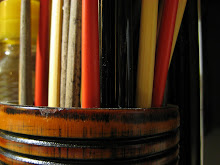


I had the good fortune of learning more about Ginseng from a friend who came avisiting a few days ago. I consider her a Ginseng buff even though she may vehemently deny it out of modesty. But, Audrey has a good knowledge of it, believe me. We spent 2 hours in a Chinese Herbal Shop in Portland gathering as much information as we could from the proprietor and his wife about the type of Ginseng they sell. Grilling is more the word. We felt confident that they personally flew to a ginseng farm in Wisconsin to select their precious roots. They had the big barrels in the back to show us. The husband and wife team would hand-pick and sort the roots. Like everything in life, there are different grades to everything. You pay more for the top grade and vice-versa.
The first picture shows the whole Ginseng root intact. In Cantonese, the top part of the root which looks like a knob,is called "Pao Sum". It is cut off and that is highly-priced because it is the most potent. At this particular Herbal shop, that part is sold for US$70 a pound! The longer part is called "Yong Sum". As it goes down, the grade is lower and thus, the cost. I think it was around US$50 a pound. The last part, the straggly stringy roots is called "Sum Soe" meaning "Ginseng Whiskers" and that costs the least. It is either ground up for tea or made into Ginseng capsules.
Audrey spent a few hundred dollars worth but in the back of her mind, she still needed to make sure that she was not had. So, we did a testing that night. I gave her a piece of "Yong Sum" from my own pantry. For quality control , Audrey placed three knobs of the "Pao Sum" which measured the same length of the "yong sum" and placed the different ginseng in two separate saucepans and slowly boiled them under an-inch of water for ten minutes. Dried Ginseng is rock-hard and never attempt to break pieces of it apart with your teeth. Her recently bought Ginseng had a strong aroma. We couldn't smell any from mine. Remember, the difference is hers is a "Pao Sum" whilst mine is "yong sum". After ten minutes, the roots have softened and she was able to slice them up into thin pieces. She placed the slices back into their individual saucepans and allowed it to simmer another 20 minutes more until one sees a yellowish hue in the water. The ginseng has infused into the liquid. She pours them out into some glasses and we all did a Ginseng test. You should have seen us, we were like wine critics, remarking on the bitterness of the drink; how well it went down the throat. If one never knows it, one would think we really knew what we were talking about. It was hilarious! But, I should speak for myself. I am a learner in all of this. What was the verdict? My Ginseng gave out a more yellowish hue than Audrey's "pao sum". Some of us agreed that my "yong sum" had a more pronounced ginseng taste, but at the same time we agreed that the "pao sum" also had a strong taste to it. In the end, we became lost in our reasoning and taste. Which can only mean one thing, that Audrey need not have worried. She bought the right thing....until she remarked, that the ginseng slices she tasted in her mouth, seemed to taste like potatoes!! At that stage, I said, "Okay! Time to go to bed!!" Could it be we were all "intoxicated" by Ginseng???










